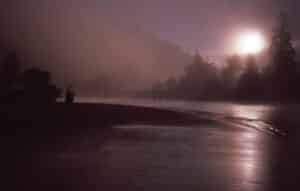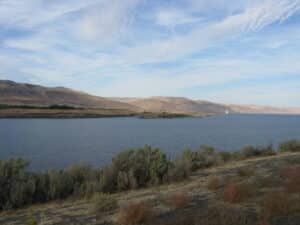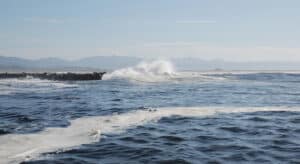Documents
Stay Informed
News
Columbia River – Roll On
Lifeline of the Northwest
The Columbia River is a lifeline of the Northwest. Beginning in a small mountain lake in British Columbia, the river collects the water drained from a massive basin—259,000 square miles across seven states and one Canadian province—until it meets the Pacific Ocean in an estuary that serves as a nursery to innumerable species. The seasonal turbulence of this great river has been severely restricted by 211 major dams across the basin including 34 along the Columbia and Snake Rivers. Once a free-flowing river, the Columbia is now a series of slack-water reservoirs. The Columbia that for centuries tied salmon-spawning streams across the region to the Pacific Ocean now struggles to do so, and the salmon and steelhead that depend upon it for their ocean-to-freshwater life cycle have been designated as threatened and endangered under the Endangered Species Act.
The vast drainage basin also empties its wastes into the Lower Columbia River where in recent times levels of toxic pollution have been high enough to cause reproductive failure in bald eagles, mink, and otter. Logging, farming, grazing, mining, and urban runoff add pollution to that discharged by cities and industries. The Columbia suffers a myriad of water pollution problems—from temperature to toxics—and a massive loss of habitat. Over a period of 150 years, the lower 46 miles of the Columbia had lost over 75 percent of its tidal swamps and over 65 percent of its marsh swamps, mostly from diking wetlands.
The Lower Columbia Gets Some Attention
Today there is some attention but very little protection given to protecting and restoring the Columbia. NWEA played a pivotal role in first bringing attention to the Columbia, a river forms the border between Oregon and Washington and had also fallen through the cracks of the two states’ regulatory systems. Starting in 1988 with the publication of Water Quality in the Columbia Gorge; A Preliminary Investigation, the first-ever report on water quality of the Columbia River, NWEA raised the alarm. This was followed by the publication of two poster-sized, full-color educational maps and a boat-based educational program called Columbia/Willamette RiverWatch.

…Yes my conception of liberty does not permit an individual citizen or group of citizens to commit acts of depredation against nature in such a way as to harm their neighbors, and especially to harm the future generations of Americans...
The Pointless Deepening of the Columbia’s Shipping Channel
Despite the massive loss of habitat in the Columbia River estuary, in 2003 the Army Corps of Engineers finalized its proposal to deepen the 150 miles of shipping channel from the mouth of the Columbia to Portland by three feet. In 1999, scientists at the National Marine Fisheries Service (NMFS) had called channel deepening an “incremental insult” to an already degraded ecosystem and one that is essential to every migrating salmon and steelhead in the Columbia system. Even scientists at the Corps had pointed out that a combination of dredging and operating the dams along the Columbia was causing sand to erode from beaches along the Pacific into the Columbia River, the opposite direction than nature intended. But that didn’t stop NMFS or the U.S. Environmental Protection Agency (EPA) from climbing aboard this Corps project promoted by the Port of Portland.
In 2004, NWEA sued NMFS and the Corps on the basis that the channel deepening project violated the National Environmental Policy Act (NEPA) because the Corps had failed to 
In the federal district court, NWEA experienced a rare loss. In 2006, the Ninth Circuit upheld the lower court’s rejection of NWEA’s claims in a 2-to-1 vote, albeit with a long and thorough dissent. Time has vindicated NWEA’s positions even if the courts did not. In 2004, NWEA’s expert economist Ernie Niemi told the court that the Corps had vastly understated the cost of channel deepening, including the costs of erosion. He also demonstrated that the Corps had vastly overstated the economic benefits of the project by relying on unsupported assumptions that amounted to a “if we build it, they will come” approach. Two thirds of the benefits were to come from predicted container cargo at the Port of Portland. By 2016 the Port of Portland had lost 100 percent of its container business.
The Corps Eats its Own Jetties and More
Mouth of the Columbia River
Meanwhile, the beach erosion caused by the Corps’ dredging and dam projects is literally undermining the jetties that hold open the Mouth of the Columbia River for ships. Built on a sand foundation, three jetties that total 9.7 miles are being held together until some very expensive plan is hatched and funded by Congress. Not only are the jetties’ sand foundations eroding but wave heights and storm activity have been increasing, threatening their integrity. Meanwhile, the coastline on the northern tip of Clatsop Spit in Oregon has eroded by more than 1,100 feet. By 2010, wave action from the Pacific threatened to breach the remaining dunes and reconnect Trestle Bay—a lagoon off the Columbia River—directly to the ocean. As with the purported economic benefits of channel deepening, once again, NWEA’s position on the channel deepening project has been vindicated.
Court Wins for Puget Sound & Columbia River
Columbia River Cold-Water Refuges Sought for Salmon
Salmon Migration in Hot Columbia River: Part 2
| Columbia River Refugia Orders 2025 | May 7, 2025 | Columbia River Refugia Orders February Order: The Court GRANTS IN PART and DENIES IN PART Plaintiff’s... | Download |
| Letter to US EPA re: WA Energy Facility Siting Council | September 12, 2023 | Failure of the Washington Energy Facility Site Evaluation Council to Comply with Public Notice and Comment... | Download |
| CGS NPDES Fact Sheet 2023 | July 1, 2023 | This fact sheet explains and documents the decisions the Energy Facility Site Evaluation Council (EFSEC)... | Download |
| Columbia River Refugia 2021 Complaint | November 2, 2021 | NWEA Columbia River Refugia 2021 complaint seeks an order holding unlawful and setting aside relevant... | Download |
| Columbia River Refugia Compliant 2021- News Release | November 2, 2021 | Government paperwork does not help salmon and steelhead migrate through the overheated waters of the... | Download |
| Briefing Paper on Simpson Snake River Dam Proposal | March 29, 2021 | Proposal would exchange breaching dams for suspending bedrock environmental laws We strongly support... | Download |
| Comments on EPA Columbia River Refugia Plan | December 2, 2019 | NWEA recently submitted detailed comments on EPA Columbia River Refugia Plan. Despite the victory of... | Download |
| Columbia River Refugia EPA Presentation | September 15, 2016 | Columbia River Refugia EPA Presentation done in September 2016 ... | Download |
| Columbia River Refugia NMFS | November 3, 2015 | Columbia River Refugia NMFS The EPA shall work with NMFS to facilitate an inter-agency team, including... | Download |
| Washington Impaired Waters 2012 List | May 15, 2015 | NWEA comments on Washington Impaired Waters List (303d) 2012. There are two separate documents; the... | Download |


